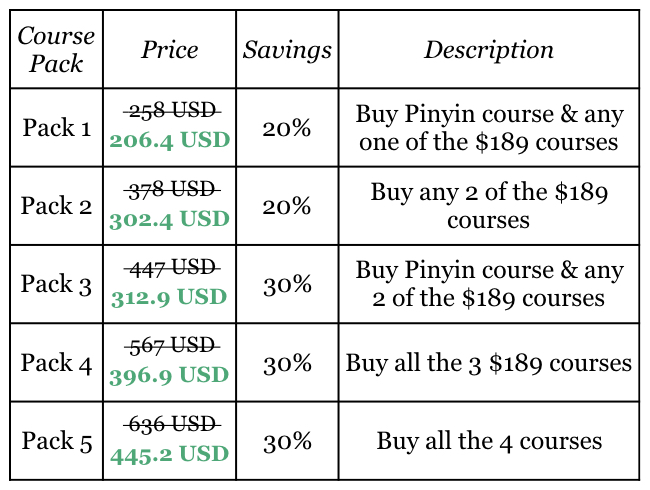Description
WHO IS THIS COURSE FOR?
- This course is for people who want to learn Chinese but have no or little previous experience. We start with the absolute basics.
- It will also be useful for people who want to refresh their existing basic knowledge of Chinese.
- This course can be used to prepare for the test of HSK Level 1. It covers almost all the vocabulary and grammar points of the test of HSK Level 1.
- This course focuses on listening comprehension and speaking, so people who are eager to understand and talk to Chinese people should take this course.
- People who want to build a solid foundation for basic Chinese grammar will benefit a lot.
- This course is perfect for people who plan to learn Chinese all by themselves or with limited time.
- It will also be a good complement for people who already attend a Chinese class.
- This course is not for the students who want to learn Chinese characters.
HOW IT WORKS?
- Step 1: Watch a video lecture with detailed and clear explanations of how to use each of the vocabulary and grammar.
- Step 2: Listen to and read a realistic dialogue online, or download the audio and script to practice anytime, anywhere.
- Step 3: Take the online quiz to check your understanding about each lesson and consolidate what you have learned.
WHAT AM I GOING TO GET FROM THIS COURSE?
After working through this course, your Chinese level will be equal to the HSK Level 1. You will be able to understand and use simple and basic Chinese that is closely related to personal or everyday life, such as greeting others, asking and introducing someone’s name and nationality, asking for someone’s telephone number, asking about the time and date, making a simple suggestion and request, reading numbers from 0~999, making a simple phone call and asking for price, etc.
COURSE CONTENT
Lesson 01: (Please log in to view this sample lesson)
Lesson 02
- Introducing and asking someone’s nationality
- “Yes-no” question with “ma”
- The possessive particle “de”
- Addressing people with their job title
Lesson 03
- Introducing where someone is
- Talking about where someone’s hometown is
- “Men” is used after “wǒ”, “nǐ”, “tā” to denote plurality
- The two adverbs “yě” and “dōu”
- Reviewing how to answer “yes-no” question
Lesson 04
- Numbers from 0 to 9
- Asking for someone’s telephone number
- Reading telephone numbers
- Reviewing how to answer “yes-no” question
- Expressing thanks
Lesson 05
- Numbers from 10 to 99
- Expressing the date
- Asking about the date
- The question words “nǎ” and “jǐ”
Lesson 06
- Asking if someone is busy
- Sentences with an adjectival predicate
- Five temporary words
- Making a suggestion
Lesson 07
- Five parts of the day
- Greeting people in the morning
- Going to someplace to do something sometime
- Reviewing how to make a suggestion
Lesson 08
- Seven days of the week
- Asking about the day of the week
- Asking the same question briefly
Lesson 09
- Family members
- The Chinese measure word “gè”
- How to read “2” when it’s before a measure word
- Asking about small numbers with “jǐ”
- Identifying people with the question word “shéi”
- The word order of Chinese questions
Lesson 10
- Expressing the time
- Asking the time
- The verb “jiàn”
- Asking how they think about your suggestion
Lesson 11
- Expressing the year
- Asking about someone’s age
- How to say “this” and “that” in Chinese
- The new meanings of “kàn” and “huì”
- Using “duì” to give an affirmative response
Lesson 12
- Expressing one’s desire with “xiǎng”
- Using “háishi” to make an alternative question
- Making polite requests with “qǐng”
- Addressing a man or woman with their family name
Lesson 13
- The new meaning of the phrase “zěnmeyàng”
- Another way to make a “yes-no”question
- Reviewing the difference between “jǐ” and “duōshao”
- Numbers from 100 to 900
- “Dànshì” and “Kěshì”
Lesson 14
- “Action Verb + le” indicating the action has already happened
- “Méi + Action Verb” indicating the action has not happened
- Three grammatical structures with measure word
- How to say “some”, “these”, “those” in Chinese
Lesson 15
- How to say “make a call” in Chinese
- Saying “Hello” on the phone
- Introducing yourself on the phone
- Identifying someone on the phone
- Asking if someone is there on the phone
- How to say “Sorry” and “Never mind” in Chinese
- Asking for sick leave in Chinese
Lesson 16
- “Zěnme + Verb ” means “how to do”
- Numbers from 0~999
- Asking for price
- Asking about different time
- “Shénme shíshou” is used to ask “when”
Lesson 17
- Indicating location with “zài”
- “A is in front of B” and “A is behind B”
- Indicating existence with “yǒu”
- Taking plane/train/subway/taxi
- “Shénme shíhou” and “……de shíhou”
Lesson 18
- “A is on B” and “A is under B”
- “A is inside B” and “A is outside B”
- Indicating actions or events in progress with “zài”
- “Kàn” and “Kànjiàn”
- “Dà” and “Xiǎo”
Lesson 19
- Talking about the weather
- Asking if someone is available
- Making an invitation
- Asking for permission
- “Duō” and “Shǎo”
Lesson 20
- Reviewing the word “le”
- “Shì……de” is used to express emphasis
- Words about food


